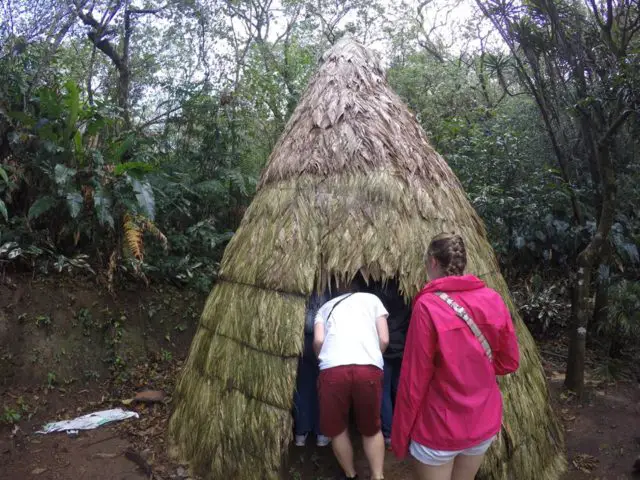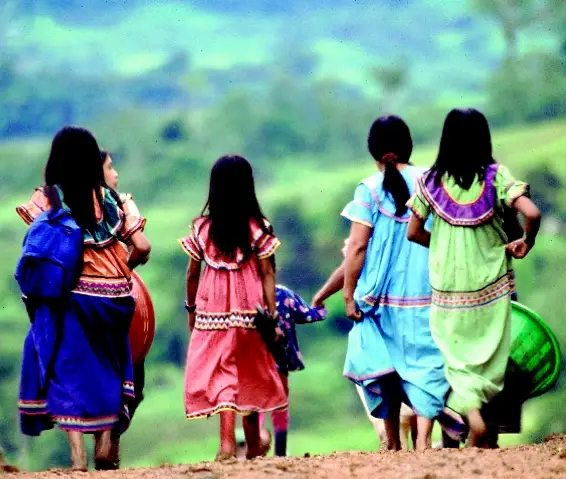The Huetares were in the 16th century the most important community in what is now central Costa Rica, being the main population when the European conquerors arrived. Its name derives from “Huetara”, the term with which the Spaniards recognized the chief of Pacaca (now Tabarcia, east of Santiago de Puriscal), so they assigned that name to all the inhabitants of that region.
A small group Hunter has been able to survive to our days, composed of approximately 1000 individuals. They are located at the top of the Quitirrisí Indigenous Reserve, on the road between the canton of Mora and that of Puriscal. There is another Huetar settlement in Zapatón, in the canton of Puriscal, both in the province of San José. There are also scattered families in the area of Cerrito de Quepos and neighboring places. These communities have lost its original language, but still retain some of their traditional beliefs, crafts, cuisine, and medicine.
Ethnohistory

The first chronicles on the Huetares date back to the 16th century and already at that time, the first demographic data of them was provided by Perafán de Rivera according to Quesada (1996), who concluded that there were approximately 11,500 Huetar natives by 1569. At that time in the Central Valley, the cacicazgos (chieftains) were Garabito, Pacaca, Aserrí, Curridabát, and Guarco and all formed two larger units that were called Señorios (manors),
To the north of the Costa Rican territory, near the plain of the San Carlos River, was another cacicazgo group called the Votos. The available information indicates that their houses were distributed near the San Juan River, some distance from each other, at the mouth of the San Carlos, and that they were inhabited by the chiefs and their families, who communicated quickly with each other by paths or there travel was by canoes over the rivers.
It is mentioned, according to several studies, that the Votos were then absorbed by the Huetares in colonial times, while others remained within the current Maleku group.
The geographical scope of the huetares
It has not been determined exactly which indigenous peoples of Costa Rica should be considered strictly as Huetares. The Huetar language seems to have been spoken or at least comprised most of the communities that inhabited the Costa Rican territory belonging to the cultural space known as the Intermediate Area, especially in the Central Valley and the river basins Virilla and Grande de Tárcoles until the Pacific coastline.
As common characteristics of these communities, it is worth mentioning relatively dispersed settlement patterns; agriculture based on corn, beans, and other crops; great refinement in the artisan works of objects in stone (metates, sculptures, tables, and ceremonial altars, etc.), absence of anthropophagy, etc. However, there was no political unity between them, and rather there seems to have been a wide variety of relationships, ranging from subordination and alliance to enmity and warfare. Some of the main Huetar kingdoms seem to have been those of King Garabito, on the Pacific side; the Kingdom of Pacaca, and the vast domains of the Guarco and Correque Kings, which extended from the banks of the Virilla River to Chirripó.
Life and customs

Its main economic activity consisted of sowing tubers, such as cassava, and pejibaye palm. From the latter, they processed the chicha, with which they got drunk in religious ceremonies and from whose trunk they made bows and arrows. Other crops they developed, although minor, were corn and cocoa. Trade development was based on barter. They complemented the agriculture with the hunting, carried out with bows and arrows, blowguns, traps, circles of fire, etc., and also fishing done with nets, with the hands, with arrows, etc. The usual cloth they used in their dresses was made of Guarco.
To the north of the Costa Rican territory, near the plain of the San Carlos River, was the cacicazgo of the Votos whose settlements communicated quickly with each other by paths or
using the sound produced by the bark of a tree that the conquerors called “mastate”. On this particular, Doris Stone indicates that “men wore loincloths and short vests, and women petticoats that reached the knees, but wore cotton clothing on special occasions”. The chief possessed the authority, obtained in the hereditary form. Its social organization was divided into three groups: the upper class, formed by the chieftain and his family, as well as by priests and sukias or sorcerers, the middle class constituted by the common people, and last the slaves, who occupied the lowest stratum in the society. War conflicts were common practice. Among their customs was to kill the prisoners and cut their heads, which they held as a trophy. Even the women went to war and helped their men either by throwing spears and sticks or by throwing stones at the adversaries.
The Huetares worshiped the Sun and the Moon. To that end, they built altars and stone mounds. Also, they revered the bones of their ancestors. They buried the remains of the deceased along with various objects that belonged to him in life and his slaves, sacrificed for that reason, as they were intended to be useful in the other life. Human sacrifice was commonly practiced in funeral or religious activities. They selected a group of people, who were led to the altar, where they would be sacrificed. In 1527, Fernández Oviedo wrote about it: They take a woman or man … and take him/her up on the hill and open them by the side and take their heart out, and the first blood would be sacrificed to the sun. And then they decapitate that person along with another four or five on a stone … and throw the bodies down to roll … where they were collected, and then eaten by the holy men as a very precious delicacy.
As a curious fact, it is appropriate to mention that they distinguished themselves by their artisan works in stone, among which they made elongated plates with human figures on top, crouched figures, warriors who held axes and trophy-shaped heads, pyramid-shaped stones with inscriptions and drawings.

At Resonance, we aspire to live in harmony with the natural world as a reflection of our gratitude for life. We are co-creating an inspired and integrative community, committed to working, living and learning together. We resonate with that deep longing to belong to the hive and the desire to live the highest version of ourselves in service.
